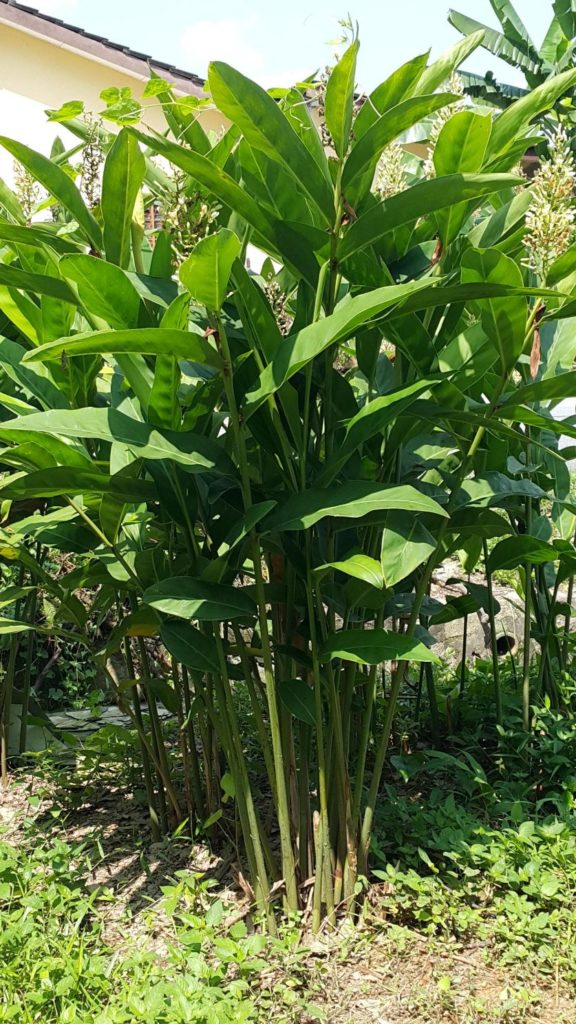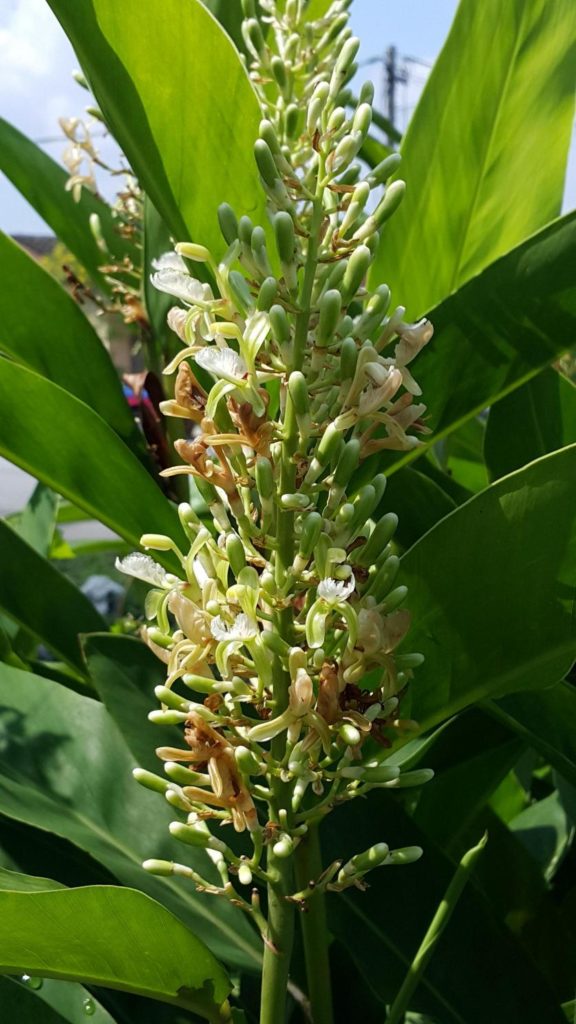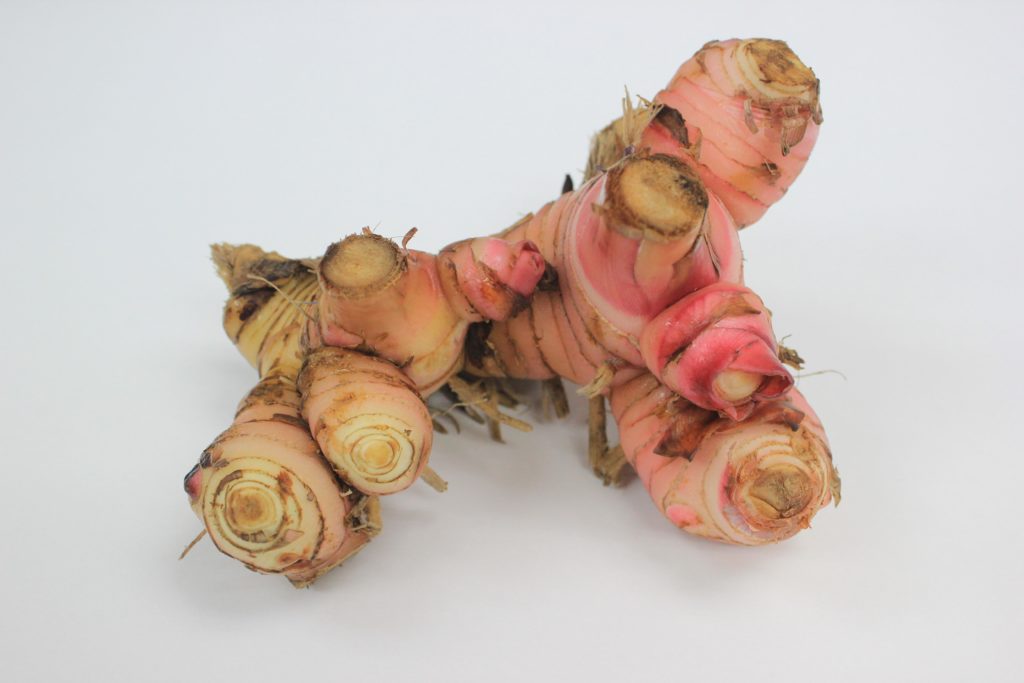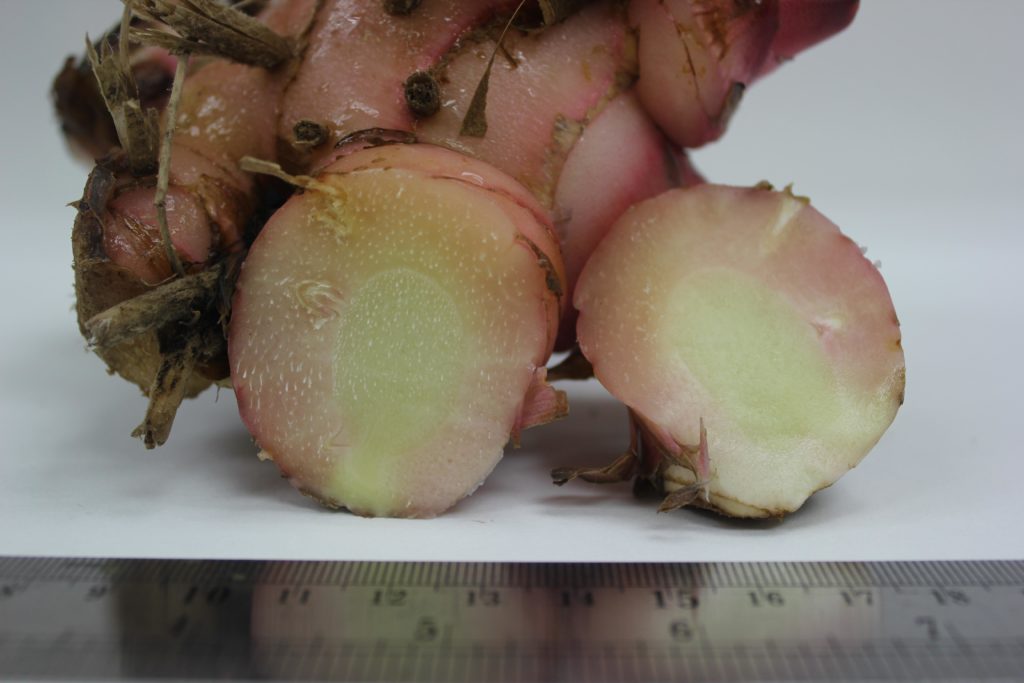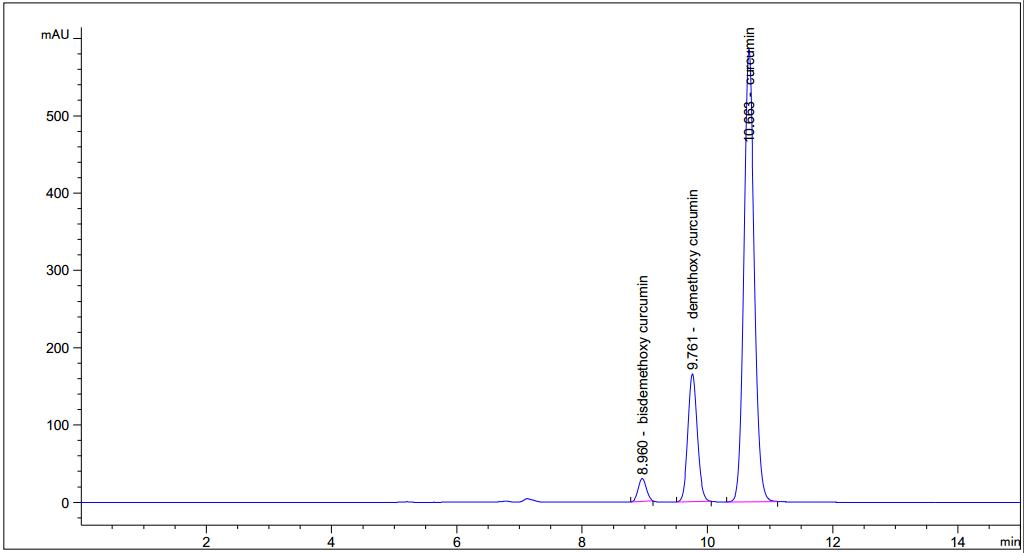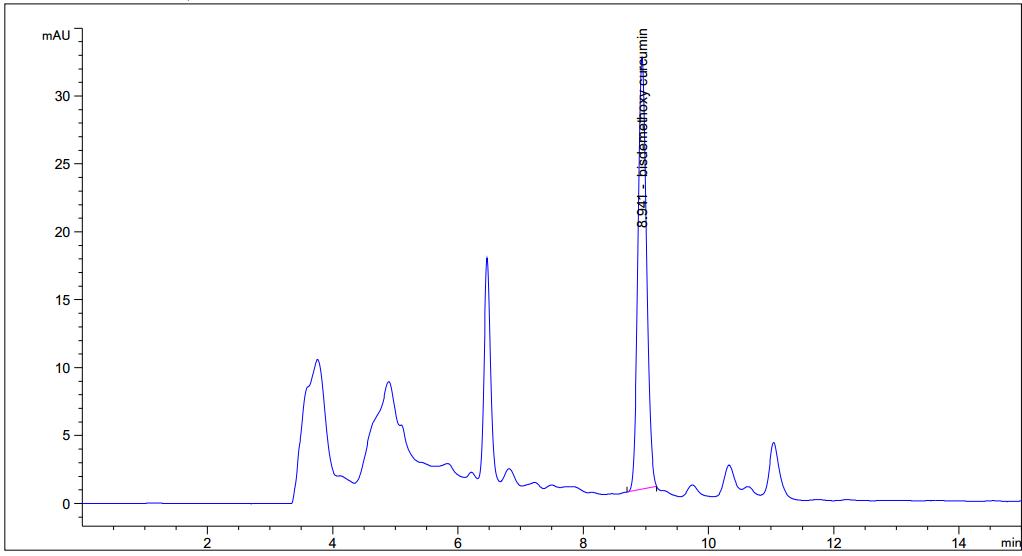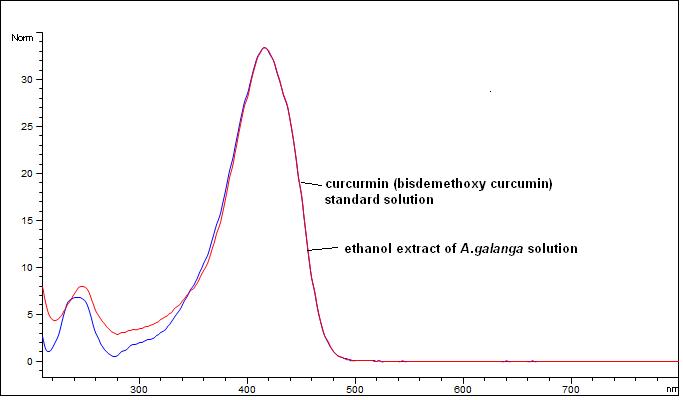Lengkuas Rhizome
Alpinia galanga (L.) Willd.
Zingiberaceae
DEFINITION
Lengkuas rhizomes consist of the powder of dried rhizomes of Alpinia galanga (L.) Willd. (Zingiberaceae) [ 1 ].
SYNONYM
Alpinia alba (Retz.) Roscoe, Alpinia bifida Warb., Alpinia carnea Griff., Alpinia pyramidata Blume, Alpinia rheedei Wight, Alpinia viridiflora Griff., Amomum galanga (L.) Lour., Amomum medium Lour., Galanga officinalis Salisb., Hellenia alba (Retz.) Willd., Heritiera alba Retz., Languas galanga (L.) Stuntz, Languas pyramidata (Blume) Merr., Languas vulgare J.König, Maranta galanga L., Zingiber galanga (L.) Stokes, Zingiber medium Stokes, Zingiber sylvestre Gaertn [ 2 ].
VERNACULAR NAMES
Greater galangal (English);Lengkuas (Malay); hong dou kou, da gao liang jiang (Chinese); arattai, perarattai (Tamil); [ 1 , 3 , 4 , 5 ].
CHARACTER
IDENTIFICATION
Plant Morphology
A. galanga grows from rhizome underneath the ground; young stem sprouts out from the base of the old stem. Stem non-woody, soft, watery, smooth and green in color. Rhizomes cylindrical, woody, branched, 2.0–8.0 cm in diameter with distinct nodes and internodes, 2–8 cm × 2–3 cm in length, longitudinally ridged with prominent rounded warts (remnants of roots) marked with fine annulations; the skin is deep orange or reddish-brown, internally orange yellow or pale buff colour; fracture hard and fibrous, cylindrical branches are short with swelling base of the aerial shoot and becoming subglobose, direction of growth is horizontal and the surface is rough, marked with wavy annulations of the leaf bases that are circularly arranged and have lighter colour than the remaining surface. Leaves lanceolate with pointed end, 24–27 cm long, 3.5–11.5 cm wide, upper surface of leaf dark green and lighter green underneath, leaf margin is wavy; petiole short, 1.0–1.5 cm long; ligule (tongue shape) brown with very fine hairs. Inflorescence terminal with a large peduncle, bell shaped, 12 cm long, greenish white. Flowers at lower down the stalk is more (3–6) compared to the upper part (1–2); bract lanceolate, pointed, thin and glabrous, size of the bract reduces towards the peak of the peduncle. Rootlets adventitious, in groups, fibrous, persistent in dried rhizomes, about 0.5–2 cm long, 0.1–0.2 cm in diameter, yellowish brown in colour [ 1 , 4 , 9 , 10 , 11 ].
Microscopy
Powdered material consists of abundant starch granules with simple and ovoid in shape; vessels are found singly or associated with abundant fibres , very few large ones and many small fragments; vessel cell wall has reticulate and annular thickenings; fibres have thick,septate cell wall and are found in group ;parenchyma cells are abundant, fairly large in six, thin walled, square-shaped to elongated with small intercellular spaces and oil secretion cells; prism calcium oxalate crystals are also observed [ 1 , 3 ].
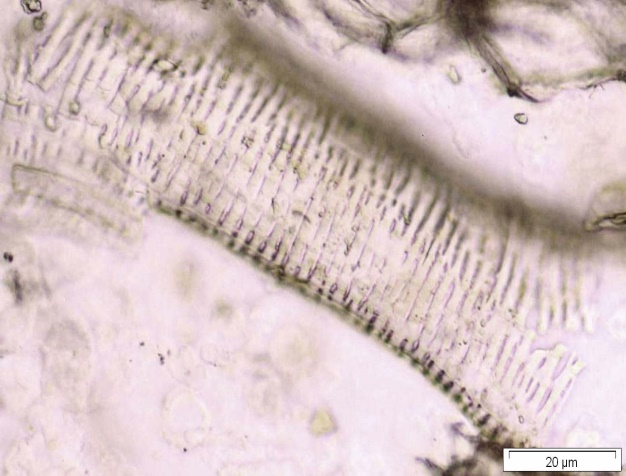
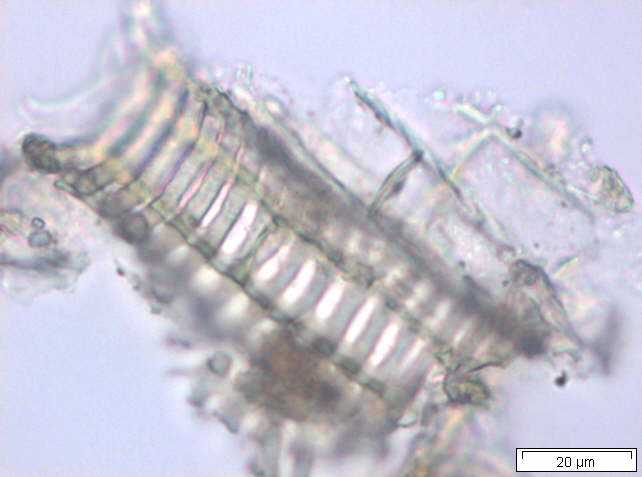
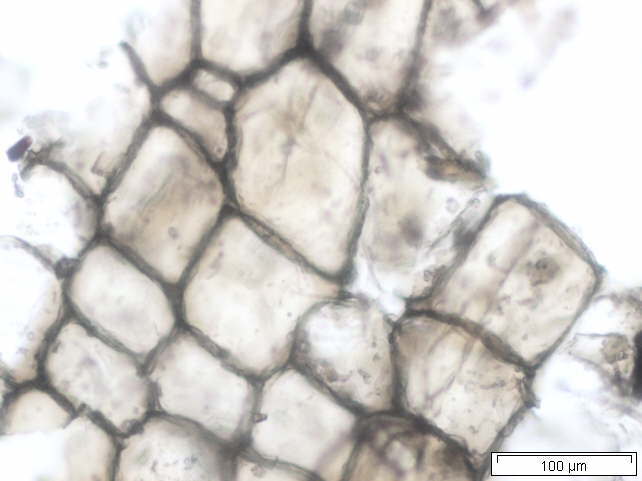
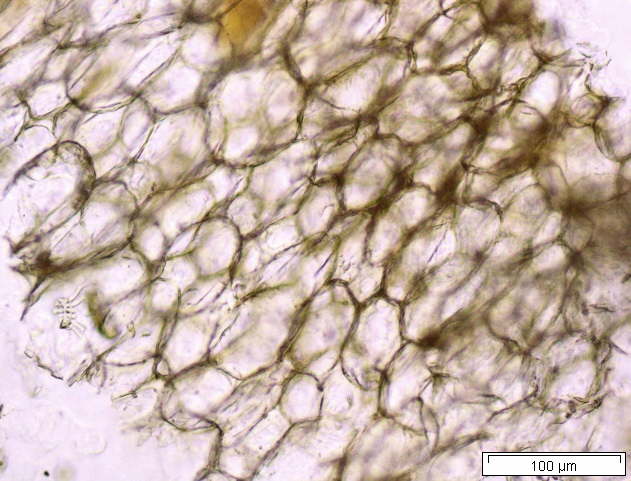
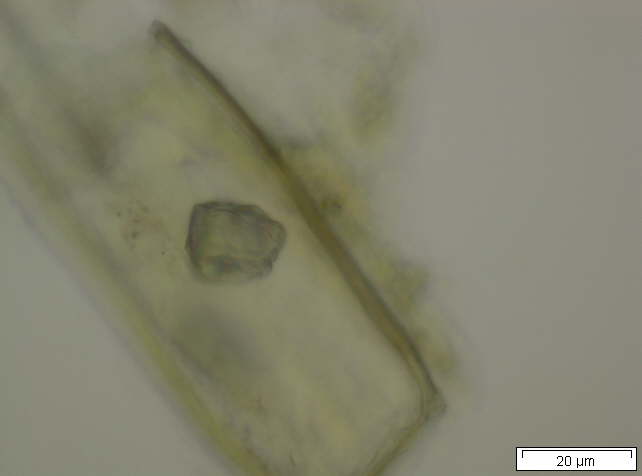
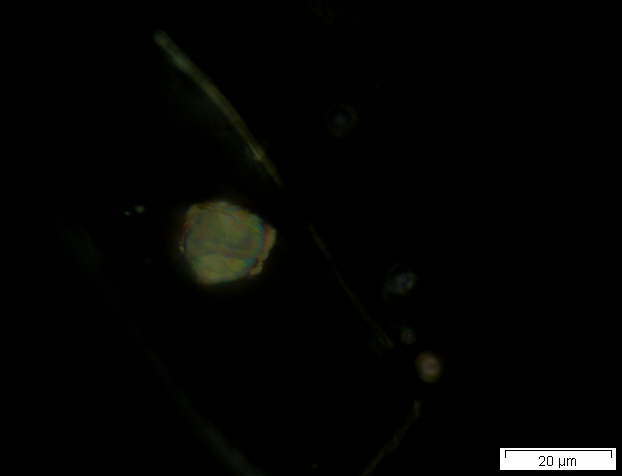
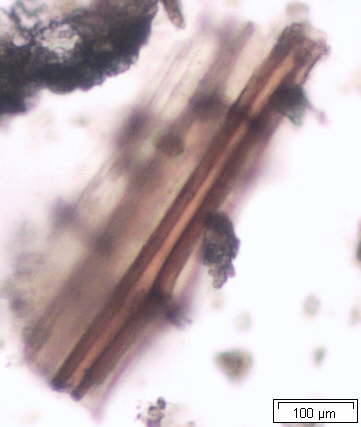
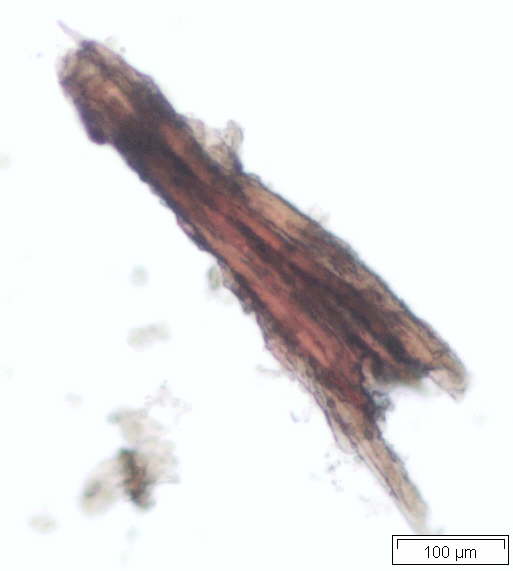
Figure 2 : Microscopic characters of Alpinia galanga rhizomes powder of 0.106 mm size. (a) Reticulate vessel (magnification 400x); (b) annular vessel (magnification 400x); (c) square-shaped parenchyma cells (magnification 100x); (d) elongated parenchyma cells (magnification 100x); (e–f) prism calcium oxalate crystal (magnification 400x); (g–h) lignified fibres with presence of numerous starch cells (magnification 100x). [Scale bars: a, b, e, f = 20 μm; c, d, g, h = 100 μm]
Thin Layer Chromatography (TLC)
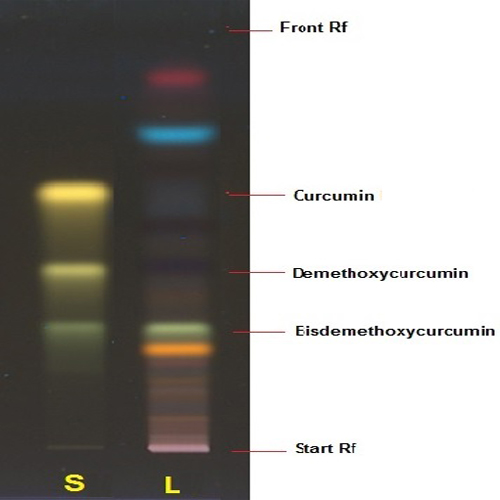
Figure 3 : HPTLC chromatogram of curcumin standard solution containing bisdemethoxycurcumin (S) and ethanol extract of Alpinia galanga dried rhizomes powder (L) observed under UV at 366 nm.
| Test Solutions | Weigh 5.0 g of A. galanga dried rhizomes powder of 0.106 mm size in a 250 mL screw-capped conical flask and add 100 mL of absolute ethanol. Extract the mixture at a temperature of 60°C for 30 min and filter. Evaporate the solvent to dryness using a rotary evaporator at 40°C. Reconstitute the extract with 10 mL of methanol, sonicate for 15 min, centrifuge at 1800 rpm for 10 min. Filter the supernatant and use the filtrate as test solution. |
| Standard solution | Dissolve curcumin standard (CAS no.: 458-37-7) in methanol to give a standard solution of 0.1 mg/mL. |
| Stationary Phase | HPTLC Glass Silica Gel 60 F254, 10 × 10 cm |
| Mobile phase | Dichloromethane : methanol; (25 : 1) (v/v) |
| Application |
|
| Development distance | 8 cm, manual chamber |
| Drying | Air drying |
| Detection |
|
High Performance Liquid Chromatography (HPLC)
| Test solution | Weigh 5.0 g of A. galanga dried rhizomes powder of 0.106 mm size in a 250 mL screw-capped conical flask and add 100 mL of absolute ethanol. Extract the mixture at a temperature of 60°C for 30 min and filter. Evaporate the solvent to dryness using a rotary evaporator at 40°C. Reconstitute the extract with 10 mL of methanol, sonicate for 15 min, centrifuge at 1800 rpm for 10 min. Filter the supernatant through a 0.45 µm nylon membrane filter and inject the filtrate into the HPLC column. |
| Standard solution | Dissolve curcumin standard (CAS no.: 458-37-7) in methanol to give a standard solution of 0.5 mg/mL. |
| Chromatographic system |
Detector: UV 425 nm Column: C18 (5.0 µm, 4.6 mm I.D × 250 mm) Column oven temperature: 25°C Flow rate: 0.5 mL/min Injection volume: 5 µL sample; 1 µL standard |
| Mobile phase (Isocratic mode) | Acetonitrile-orthophosphoric acid (0.1%) in water (60 : 40 v/v) |
| System suitability requirement |
15 min |
| Acceptance criteria |
Perform at least five injections of curcumin standard solution (0.5 mg/mL). The requirements of the system suitability parameters are as follow:
|
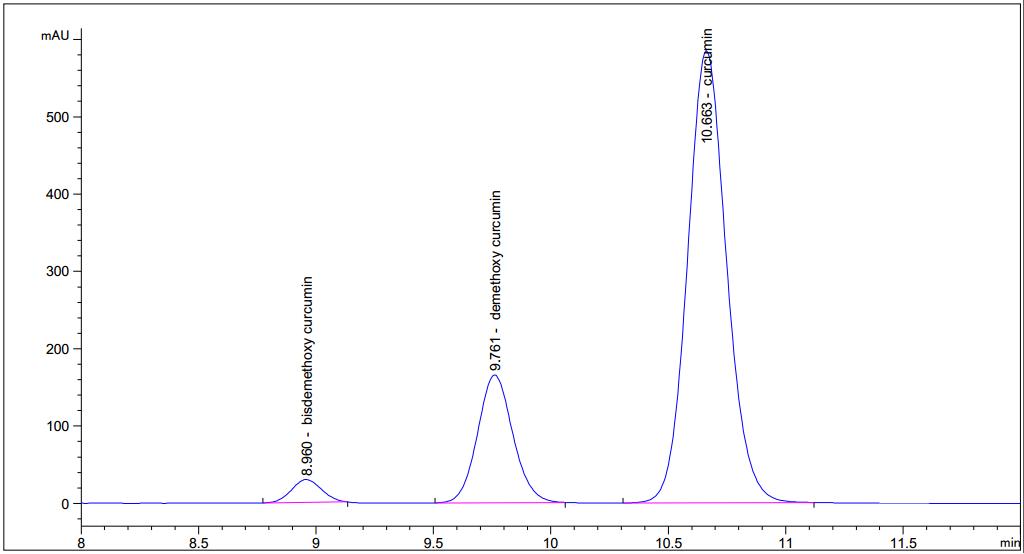
(a)
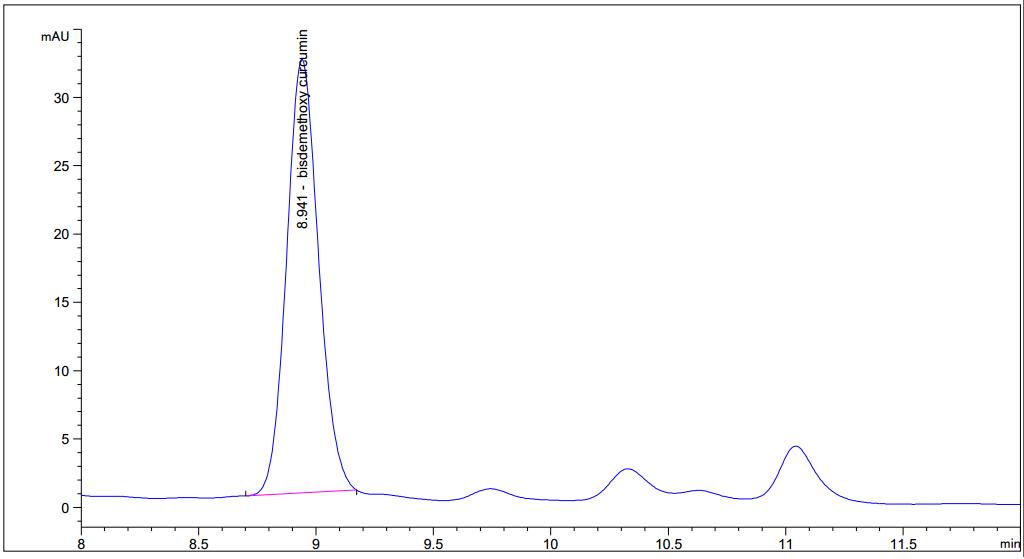
(b)
Figure 5 : HPLC chromatogram highlighting the elution region of (a) curcumin standard solution (0.5 mg/mL) containing bisdemethoxycurcumin peak at tr = 8.960 min and (b) ethanol extract of Alpinia galanga dried rhizomes powder showing a peak corresponding to bisdemethoxycurcumin at tr = 8.941 min.
PURITY TESTS
The purity tests, except foreign matter test, are based on A. galanga dried rhizomes powder of 0.106 mm particle size.
| Foreign Matter |
| Not more than 2% |
| Ash Contents | |
| Total ash | Not more than 14% |
| Acid-insoluble ash | Not more than 8% |
| Loss on Drying |
| Not more than 13% |
| Extractive Values | |
| Water-soluble extracts | |
| Hot method | Not less than 15% |
| Cold method | Not less than 13% |
| Ethanol-soluble extracts | |
| Hot method | Not less than 6% |
| Cold method | Not less than 4% |
SAFETY TESTS
The safety tests are based on A. galanga dried rhizomes powder of 0.106 mm particle size.
| Heavy Metals | |
| Arsenic | Not more than 5.0 mg/kg |
| Mercury | Not more than 0.5 mg/kg |
| Lead | Not more than 10.0 mg/kg |
| Cadmium | Not more than 0.3 mg/kg |
| Microbial Limits | |
| Total bacterial count | Not more than 105 cfu/g |
| Total yeast and mould count | Not more than 104 cfu/g |
| Bile-tolerant gram negative | Not more than 104 cfu/g |
| Specific Pathogens | |
| Salmonella spp. | Absent in 25 g |
| Escherichia coli | Absent in 1 g |
| Staphylococcus aureus | Absent in 1 g |
| Pseudomonas aeruginosa | Absent in 1 g |
CHEMICAL CONSTITUENTS
The aqueous acetone (80%) extract of the rhizomes of A. galanga was found to contain phenylpropanoids (e.g. 1’-S-1’-hydroxychavicol acetate, methyleugenol, chavicol β-D-glucopyranoside, ρ-coumaryl diacetate, ρ-coumaryl alcohol, 1’-S-1’-acetoxychavicol acetate, 1’-S-1’-acetoxyeugenol acetate, trans-ρ-hydroxycinnamaldehyde, trans-ρ-hydroxycinnamyl acetate, trans-ρ-coumaryl alcohol, trans-ρ-coumaryl diacetate, ρ-hydroxybenzaldehyde), neolignans (e.g. galanganal, galanganols A, galanganols B) and sesquineolignan (e.g. galanganol C) [ 12 , 13 ].
The aqueous acetone (95%) extract was found to contain phenylpropanoid (e.g. 4, 4′[(2E, 2’E)-bis(prop-2-ene)-1,1′-oxy]-diphenyl-7,7′-diacetate) [ 14 ].
The aqueous methanol (80%) extract was found to contain hydroxyl-1,8-cineol glucopyranoside (e.g. (1R,2R,4S)-trans-2-hydroxy-1,8-cineole β-D-glucopyranoside, (1S,2S,4R)-trans-2-hydroxy-1,8-cineole β-D-glucopyranoside, (1R,3S,4S)-trans-3-hydroxy-1,8-cineole β-D-glucopyranoside) [ 15 ].
The methanol extract was found to contain steroidal glycosides (e.g. β-sitosterol diglucosyl caprate, β-sitosterol diglucoside, β-sitosteryl arabinoside), gallic acid glycoside (e.g. galangogalloside), flavone (e.g. galangoflavonoside) and phenylpropanoids (e.g. 1’-S-1’-hydroxychavicol acetate, 1’-S-1’acetoxychavicol acetate, ρ-coumaryl-9-methyl ether) [ 16 ,
17 , 18 , 19 , 20 , 21 ].
The hexane extract was found to contain phenylpropanoids (e.g. methyleugenol, ρ-coumaryl diacetate, 1’-acetoxychavicol acetate, 1’-acetoxyeugenol acetate, trans-ρ-acetoxycinnamyl alcohol) [ 21 ].
The chloroform extract was found to contain phenolics (e.g.ρ-hydroxycinnamaldehyde, [di-ρ-hydroxy-cis-styryl)] methane) and phenylpropanoids (e.g. trans-3,4-dimethoxycinnamyl alcohol, ρ-hydroxybenzaldehyde, ρ-hydroxycinnamaldehyde, ρ-coumaryl diacetate, coniferyl diacetate, 1’-S-1’-acetoxychavicol acetate, 1’-S-1’-acetoxyeugenol acetate, 4-hydrobenzaldehyde) [ 22 , 23 , 24 ].
The ethyl acetate extract was found to contain phenylpropanoids (e.g. trans-ρ-coumaryl alcohol, galangin, trans-ρ-coumaric acid, galanganol B) [ 22 ].
Essential oil of A. galanga rhizome has been found to contain monoterpenoids (e.g. α-pinene, β-pinene, camphene, myrcene, β-sesquiphellandrene, α-phellandrene, β-phellandrene, α-terpinene, ɣ-terpinene, sabinene, β-sabinene, trans-sabinene hydrate, cis-sabinene hydrate, ρ-cymene, ρ-cymene-8-ol, 1,8-cineole, trans-2-acetoxy-1,8-cineol, trans-3-acetoxy-1,8-cineol, cis-3-acetoxy-1,8-cineol, cis-2-acetoxy-1,8-cineol, camphor, campholenal, borneol, isoborneol, isopulegol, terpinen-4-ol, 4-terpineol, α-terpineol, 1-α-terpineol, β-terpineol, δ-terpineol, (E)-β-terpineol, terpinolene, limonene, (Z)-β-ocimene, (E)-β-ocimene, α-thujene, β-thujone, δ-3-carene, linalool, cis-linalool oxide, trans-linalool oxide, citronellal, citronellol, citronellyl acetate, ρ-cymen-8-ol, carveol I, carveol II, pinocarveol, trans-pinocarveol, trans-carveol, cis-carveol, carvone, pinocarvone, 2-hydroxy-1,8-cineole, isobornyl acetate, bornyl acetate, endobornyl acetate, bornyl benzoate, terpinen-4-yl-acetate), bisabolane-type sesquiterpenoids (e.g. α-bisabolene, β-bisabolene, trans-ɣ-bisabolene, ar-curcumene), caryophyllane-type sesquiterpenoids (e.g. β-caryophyllene, 1-caryophyllene, caryophyllene oxide, (-)-caryophyllene oxide), germacrane-type sesquiterpenoids (e.g. germacrene, germacrene D, germacrene B), elemane-typesesquiterpenoids (e.g. β-elemene, α-elemene, δ-elemene), guaiane-type sesquiterpenoid (e.g. α-guaiene), sesquiterpenoids (trans-β-farnesene, (E)-β-farnesene, (Z)-β-farnesene, (E)-β-trans-farnesene, α-humulene, trans-nerolidol, (Z)-nerolidol, (E)-nerolidol, gurjunene, α-gurjunene, β-gurjunene, ɣ-muurolene, α-muurolene, ᴛ-muurolol, α-cubebene, ɣ-cadinene, δ-cadinene, α-copaene, guaiol, ᴛ-cadinol, α-cadinol, elemol, ɣ-eudesmol, α-eudesmol, β-eudesmol, farnesol, (Z,E)-farnesol, (Z,Z)-farnesol, (E,E)-farnesol, (E,E)-farnesyl acetate), santalene-type sesquiterpenoids (e.g. santalene, α-santalene), bergamotene-typesesquiterpenoids (e.g. trans-α-bergamotene, α-bergamotene), selinene-typesesquiterpenoids (e.g. α-selinene, β-selinene, δ-selinene), and other substances (e.g. fenchone, α-fenchol, exo-fenchol, endo-fenchol, β-fenchol, α-fenchyl acetate, fenchyl acetate, bornyl acetate, zerombone, cis-ρ-menth-2-en-1-ol, trans-ρ-menth-2-en-1-ol, cis-piperitol, trans-piperitol, chavicol, methyl chavicol, chavicol acetate, carvacrol, chavicyl acetate, eugenol, eugenol acetate, o-methyleugenol, methyleugenol, geranyl acetate, tetradecane, octadecane, pentadecane, α-bisabolol, epi-α-bisabolol, β-bisabolol, 1-heptadecene, heptadecane, 1-nonadecene, tricyclene, fenchene, 1-octen-3-ol, benzyl alcohol, fenchone, α-ρ-dimethyl styrene, nonanal, myrtenal, myrtenol, verbenone, pulegone, geraniol, geranial, linalyl acetate, cis-sabinyl acetate, methyl cinnamate, (Z)-methyl cinnamate, (E)-methyl cinnamate, α-patchoulene, β-patchoulene, β-bourbonene, alloaromadendrene, viridiflorene, viridiflorol, valencene, β-chamigrene, carotol, spathulenol, globulol, ledol, cubenol, (Z)-α-bergamotol, trans-α-bergamotol, nootketone, α-ρ-dimethylstyrene, 2-methylpropyl acetate, butyl acetate, ρ-cymenol, tridecane, neryl acetate, branch C14-hydrocarbon, eugenyl acetate, methyl isobutyl ketone, amyl acetate, tricyclene, D,L-1’-acetoxychavicol acetate, ρ-coumaryl diacetate, acetoxyeugenol acetate, 9-octadecenoic acid, 5-hydroxymethyl furfural, furfuraldehyde, 2,3-dihydro-3,5-dihydroxy-6-methyl-4H-pyran-4-one, 1,2-benzene dicarboxylic acid, 4-allylphenol, 4-allylphenyl acetate, trans-3-acetoxy-1,8-cineole, trans-methyl isoeugenol, isoterpinolene, trans-ρ-mentha-2,8-dien-1-ol, ρ-mentha-1,5-dien-8-ol, cumin aldehyde, exo-2-hydroxycineole acetate, 4-(2-propenyl)phenol acetate, N-methyl-3,5-dihydroxyaniline, α-neopclovene, trans-cadina-1(6),4-diene, 2-isopropenyl-4a,8-dimethyl, ɣ-himachalene, zingiberene, δ-amorphene, silphiperfol-5-en-3-one B, spathulenol, trans-isolongifolanone, eudesm-7(11)-en-4-ol,acetate, bicycle(4.2.0)oct-1-ene,7-exo ethenyl) [ 21 , 26 , 27 , 28 , 29 , 30 , 31 , 32 , 33 , 34 , 35 , 36 , 37 , 38 ].
MEDICINAL USES
Uses described in folk medicine, not supported by experimental or clinical data
In Malaysia, the rhizomes of this plant have been traditionally used for fever, headache, cough, haemoptysis, respiratory illness, stomachache, colic, indigestion, flatulence, borborygmus, laxation, nausea, vomiting, diarrhea, menstrual pain, amenorrhoea, skin infection, ringworm, afterbirth and postpartum infection. It is also added to an ointment for skin problems [ 1 , 39 , 40 ].
In the Ayurvedic system, the rhizome is used to improve appetite, voice and taste and useful in vata, respiratory problem and for the heart. In the Unani system, the rhizomes have been used as stomachic, aphrodisiac, tonic, diuretic, expectorant, flatulence; useful in headache, inflammation of the joints, sore throat, sour belching, stuttering, chest pain and regulate blood sugar [ 4 , 14 ].
Biological and pharmacological activities supported by experimental data
Antiallergic activity
1ˊS-1ˊ-acetoxychavicol acetate (ACA) and 1ˊS-1ˊ-acetoxyeugenol acetate, isolated from aqueous acetone (80%) extract of A. galanga dried rhizomes, were investigated for antiallergic effect in vitro and in vivo. ACA and 1ˊS-1ˊ-acetoxyeugenol acetate were found to inhibit the release of β-hexosaminidase as a marker of antigent-IgE-mediated degranulation in rat basophilic leukemia (RBL-2H3) cells with IC50 values of 15 and 19 µM, respectively, compared to tranilast (IC50 = 492 µM) and ketotifen fumarate (IC50 = 216 µM). In an experimental model of type I allergy using ear passive cutaneous anaphylaxis reaction in 4 weeks old male ddY mice, ACA and 1ˊS-1ˊ-acetoxyeugenol acetate dose-dependently (6.25-50 mg/kg) inhibited the leakage of dye giving percentage inhibition of 44.3% and 37.8% at 50 mg/kg dose, respectively, comparable to tranilast (42.7% at 400 mg/kg). ACA and 1ˊS-1ˊ-acetoxyeugenol acetate also inhibited release of tumour necrosis factor-α (TNF-α) from RBL-2H3 cells with IC50 values of 17 and 15 µM, respectively, compared to luteolin (IC50 = 5.8 µM); as well as release of interleukin 4 (IL-4) with IC50 values of both compounds 12 µM, compared to luteolin (IC50 = 3.7 µM). Thus, suggesting that the compounds are effective against the late phase of type I allergic reactions in RBL-2H3 cells [ 12 ].
Human immunodeficiency virus type-1 inhibitory activity
1ˊS-1ˊ-acetoxychavicol acetate (ACA), isolated from methanol extract of A. galanga dried rhizomes, inhibited Reverse transport completely in an in vitro fission yeast Schizosaccharomyces pombe model and inhibited >80% HIV-1 replication in phytohaemaglutinin-stimulated peripheral blood mononuclear cells that were infected by HIV-1 NL4-3 and JR-CSF virus using HIV p24 ELISA antiviral assay. In a competitive binding assay, ACA was suggested to inhibit HIV-1 replication by blocking Reverse transport via chromosomal maintenance 1 (CRM1) pathway. ACA was also found to act synergistically with didanosine, indicating its possible therapeutic application with other anti-HIV agents to effectively inhibit HIV-1 replication [ 42 ].
The methanolic extract of A. galanga has been investigated for potential therapy for human immunodeficiency virus type-1 (HIV-1). The results showed that the extracts possessed 48.70% inhibition against HIV-1 at 100 µg/mL compared to acetyl pepstatin with percentage of 98.47% [ 45 ].
Cytotoxicity activity
1ˊS-1ˊ-acetoxychavicol acetate (ACA), isolated from methanol extract of A. galanga dried rhizomes, exhibited cytotoxic activity against human stomach cancer (SNU-638) and human fibro sarcoma (HT1080) cell lines with IC50 values of 1.27 and 1.20 µg/mL, respectively, compared to the positive control, ellipticine (SNU-638: IC50 = 0.81 µg/mL; HT1080: IC50 = 0.56 µg/mL) [ 43 ].
Anti-inflammatory activity
The ρ-coumaryl alcohol-ɣ-O-methyl ether (CAME) compound isolated from methanol extract of A. galanga dried rhizomes (0 – 30 µmol/L), was found to inhibit in dose-dependent manner on intracellular reactive oxygen species (ROS) generation in CD4+ Th cells isolated from the lymph nodes and spleens of C57BL6 mice. CAME showed no effect on apoptosis and viability of primary Th cells. The compound significantly (p < 0.05; 30 µmol/L) suppressed pro-inflammatory cytokine interferon-ɣ (IFN-ɣ) production in CD4+ Th cells which is beneficial in modulating inflammatory immune disorders mediated by generation of IFN-ɣ [ 25 ].
Ethanol extract of A. galanga dried rhizomes (250 mg/kg) suspended in acacia gum (2%) was given orally to male Wistar rats (150 – 200 g) with carrageenan-induced paw edema. The paw volume was measured using a digital plethysmometer at 0 and 3 hr. The extract was found to significantly (p < 0.05) reduce paw edema by 52.5% compared to a positive standard, indomethacin (68.75%, p < 0.001) [ 44 ].
Antiulcer activity
Ethanol extract (96%) of A. galanga dried rhizomes (500 mg/kg) given by intraperitoneal injection to pylorus ligated (Shay) Wistar albino rats (150 – 200 g) significantly (p < 0.05) reduced gastric secretion volume (6.16 ± 0.41) and ulcer index (0.16 ± 0.0) compared to the Shay control group (9.41 ± 1.09 and 2.0 ± 0.06, respectively). The extract (500 mg/kg) given by oral administration showed protective effect on gastric mucosa in hypothermic restraint stress-induced rats with increased gastric wall mucus (360.04 ± 40.99 μg Alcian blue/g wet glandular tissue), reduced intraluminal bleeding (0.66 ± 0.49 score, p < 0.05) and reduced ulcer index (19.8 ± 3.71, p < 0.05) compared to the hypothermic stressed group (200.72 ± 10.05 μg Alcian blue/g wet glandular tissue, 2.50 ± 0.56 score and 31.2 ± 2.40, respectively). The extract (500 mg/kg) given orally to male Wistar rats significantly (p < 0.05) reduced ulcer index of gastric lesions induced by 80% ethanol (0.16 ± 0.16 compared to control, 7.16 ± 0.3), 0.6 M HCI (1.50 ± 0.34 compared to control, 7.16 ± 0.4), 0.2 M NaOH (0.33 ± 0.21 compared to control, 7.16 ± 0.4) and 25% NaCI (0.33 ± 0.21 compared to control, 6.83 ± 0.83), suggesting its cytoprotective effect against necrotizing agent-induced gastric ulcers. However, the extract did not produce significant effect on gastric mucosal damage induced by indomethacin and reserpine [ 45 ].
Reduction of blood glucose level in normal animal
Crude powder (2 – 4 g/kg), methanol extract (equivalent to 4 g/kg of crude powder) and aqueous extract (equivalent to 4 g/kg of crude powder) of A. galanga dried rhizomes were given orally to normal male New Zealand rabbits (1000 – 1500 g). Blood glucose level was monitored using glucose oxidase method at 2, 4, 6, 8, 12 and 24 hr after treatment. Dose-dependent decrease of glucose level was observed with the crude powder treatment. After 8 hrs, the glucose level significantly (p < 0.01) reduced for 4 g/kg dose of crude powder (70.3 ± 0.6 mg/dl from 100.8 ± 0.2 mg/dl at zero hr), methanol extract (70.0 ± 1.2 mg/dl from 101.1 ± 0.1 mg/dl at zero hr) and aqueous extract (70.7 ± 1.3 mg/dl from 100.9 ± 9.1 mg/dl at zero hr) compared to gliclazide (80 mg/kg) (70.7 ± 0.9 mg/dl from 101.2 ± 0.4 mg/dl at zero hr). However, the glucose level reverted to almost the normal value within 24 hr. Unfortunately, the crude powder and extracts did not give observable effect in alloxan-induced diabetic rabbits [ 46 ].
Neuroprotective effect
Chloroform fraction of A. galanga dried rhizome ethanol extract (400 mg/kg) was given by intracerebroventricular injection to male Albino mice (22 – 25 g, 5 – 6 weeks old) with Alzheimer’s type amnesia induced by the neurotoxic β-amyloid peptide. The fraction significantly improved (p < 0.001 compared to β-amyloid-induced negative control) open field exploration parameters, that is, head dips (9.16 ± 0.60 counts/5 m), rearings (22.33 ± 0.76 counts/5 m) and line crossings (30.00 ± 1.03 counts/5 m), comparable to that of donezapil (5 mg/kg) treated group (9.50 ± 0.34, 22.83 ± 0.90 and 31.17 ± 1.07 counts/5 m, respectively) and vehicle control group (9.66 ± 0.95, 24.17 ± 0.65 and 31.33 ± 1.78 counts/5 m, respectively). The fraction also increased hippocampal memory by significantly improving (p < 0.001 compared to the negative control) water maze escape latency (56.67 ± 1.56 s) comparable to the donepezil treated (54.67 ± 0.88 s) and vehicle control (53.17 ± 1.57 s) groups [ 47 ].
Biochemical estimations were determined in the mice brain tissue homogenate. The fraction and donezapil were found to significantly recuperate (p < 0.001 compared to the negative control) Na+/K+-ATPase (0.55 ± 0.32 and 0.54 ± 0.33 μm Pi liberated/mg protein, respectively) comparable to the vehicle control group (0.57 ± 0.03 μm Pi liberated/mg protein), showing improved integrity of membrane bound plasticity. The fraction and donezapil also reversed the neurotoxicity by significantly decreasing (p < 0.001 compared to the negative control) the neurotransmitter metabolic enzyme acetylcholinesterase (12.29 ± 0.33 and 12.19 ± 0.57 μmol/min/mg, respectively) comparable to the vehicle control group (12.04 ± 0.92 μmol/min/mg), indicating improved cognition by enhancing cholinergic transmission. Both fraction and donezapil exhibited free radical scavenging property by significantly increasing (p < 0.001 compared to the negative control) antioxidant enzyme activity of superoxide dismutase (7.77 ± 0.38 and 7.82 ± 0.97 U/min/mg protein, respectively), glutathione peroxidase (32.05 ± 1.38 and 32.31 ± 1.54 U/min/mg protein, respectively), catalase (2.79 ± 0.10 and 2.89 ± 0.18 U/mg protein, respectively) and vitamin C (0.94 ± 0.02 and 0.94 ± 0.04 μg/mg protein, respectively) comparable to the vehicle control group (7.88 ± 0.46 U/min/mg protein, 32.84 ± 2.20 U/min/mg protein, 2.95 ± 0.22 U/mg protein and 0.94 ± 0.44 μg/mg protein, respectively). The study indicated that the chloroform fraction of A. galanga dried rhizome ethanol extract has neuroprotective effect in Alzheimer’s disease induced mice with almost equivalent action as donezapil [ 47 ].
Antimutagenic effect
Ethanol (96%) extract of A. galanga dried rhizomes (125 – 500 mg/kg/day) was orally administered to male Swiss albino mice (25 – 30 g, 6 – 7 weeks old) for 7 days. In another groups, the mice were pretreated with the extract (125 – 500 mg/kg/day) for seven days before cyclophosphamide (100 mg/kg) was injected intraperitoneally together with the last dose of extract. The animals were sacrificed 30 hr after the last dose. The study revealed that the extract alone had no effect on the number of micronucleated polychromatic erythrocytes in bone marrow cells, protein and nucleic acid contents in the liver and testes, and mitodepression on bone marrow in mice. However, significant changes were observed in cyclophosphamide-induced mutagenicity mice. At the doses of 125, 250 and 500 mg/kg/day, the extract significantly reduced (p < 0.05) percentage of micronucleated polychromatic erythrocytes to 3.67 ± 0.21%, 3.30 ± 0.26% and 3.10 ± 0.45%, respectively, compared to the cyclophosphamide-induced group (5.10 ± 0.50%). The dose (500 mg/kg/day) also significantly increased (p < 0.01) liver RNA and DNA contents with values of 588 ± 12 and 188 ± 6.5 μg/100 mg, respectively, compared to the cyclophosphamide-induced group (455 ± 25 and 145 ± 5.5 μg/100 mg, respectively). In another study, the minimum effective dose of extract to give these changes was found to be 125 mg/kg/day [ 48 ].
Clinical studies
Information and data have not been established.
SAFETY INFORMATION
Preclinical studies (Toxicology studies)
Acute toxicity
Hexane, chloroform and ethyl acetate fractions, and aqueous residue of ethanol extract of A. galanga dried rhizomes (5 – 2000 mg/kg) given by gastric intubation to female Albino mice (22 – 25 g) showed no signs of toxic symptoms of behavioural changes, locomotion, convulsions and mortality with LD50 of 2000 mg/kg [ 47 ].
Ethanol (95%) extract of A. galanga rhizomes (0.5, 1 and 3 g/kg) given orally to Swiss albino mice (25 – 30 g, 6 – 7 weeks old) showed no signs of toxicity and no mortality up to the 3 g/kg dose level [ 49 ].
Oral single dose acute toxicity study on female Sprague Dawley rats ( aged between 8 and 12 weeks old) using aqueous extract of A. galanga rhizomes showed no toxic effect on the parameters observed, including behaviors, body weight , food and water intake. All rats were observed for 14 days prior to necropsy. No death was found throughout the study period. Necropsy revealed no significant abnormality. Approximate lethal dose (LD50) is more than 2,000 mg/kg body weight [ 50 ].
Chronic toxicity
Ethanol (95%) extract of A. galanga rhizomes (100 mg/kg/day) was given orally to 10 male and 10 female Swiss albino mice (25 – 30 g, 6 – 7 weeks old) for a duration of three months. One mouse died during every 30, 60 and 90 days of treatment giving a total of 3 mortality (15% lethality) but was not significant (p > 0.05) compared to the control group. The extract-treated group showed significant increase in body weight (from average body weight 26.6 ± 1.0 g at pretreatment to 31.3 ± 1.5 g post-treatment, p < 0.05) and red blood cell count (extract-treated = 7.75 ± 0.20 (× 106) counts compared to control = 6.88 ± 0.30 (× 106) counts, p < 0.050). The extract-treated male mice had significant increase in weight of testis (0.69 ± 0.03 g/100 g body weight compared to control = 0.59 ± 0.02 g/100 g body weight, p < 0.05), caudae epididymidies (0.31 ± 0.01 g/100 g body weight compared to control = 0.23 ± 0.01 g/100 g body weight, p < 0.001) and seminal vesicles (0.82 ± 0.09 g/100 g body weight compared to control = 0.54 ± 0.03 g/100 g body weight, p < 0.05), as well as high sperm motility (95.0 ± 4.6% compared to control = 75.0 ± 3.5%, p < 0.01) and sperm count (5.2286 ± 0.05 count/100 g body weight compared to control = 5.0226 ± 0.04 count/100 g body weight, p < 0.05). However, spermatotoxic effects were not observed [ 49 ].
Others (Adverse reaction, contraindication, side effect, warning, precaution)
Information and data have not been established.
DOSAGE
In Ayurveda, the recommended dosage for therapeutic uses is 1 – 3 g powder of A. galanga dried rhizome powder [ 11 ].
In Myanmar, the recommended dosage for cough, fever and menstrual disorders is either 15 – 30 mL of A. galanga rhizome decoction with sugar or 1 – 2 g of dried powder [ 40 ].
STORAGE
Store below 30°C. Protect from light and moisture.
REFERENCES
- Malaysian Monograph Committee. Malaysian Herbal Monograph. Vol. 1. Kuala Lumpur: Malaysian monograph committee. 1999; p.49-51.
- The Plant List. [Internet] Alpinia galanga (L.) Willd.; 2013 [cited on 26th October 2012]. Available from: http://www.theplantlist.org/tpl1.1/record/kew-218790.
- Lakshmi A, Aravinda W. Sri Lankan medicinal plant monographs and analysis Vol. 10: Alpinia galanga. Colombo: National science foundation. 2006.
- Kirtikar KR and Basu BD. Indian Medicinal Plants. International Book Distribution, Dehra Dun 1996, Vol IV, pp. 2445-2446
- Multilingual Multiscript Plant Name Database. [Internet]. Sorting Alpinia names; 2006 [cited on 16th October 2015]. Available from: http://www.plantnames.unimelb.edu.au/Sorting/Alpinia.html.
- Kingston DG, Rao MM and Zucker WV. Plant anticancer agents IX constituents of Hyptis suaveolens. Journal of Natural Products. 1979;42(5):496-499.
- Farnsworth NR, Bunyapraphatsara N. Thai medicinal plants recommended for primary healthcare system. Bangkok: Medicinal plants information center. 1992:402.
- Uhl S. Ingredients: The building blocks for developing new ethnic foods. Food Technology. 1996;6:79-84.
- Parwaiz Akhtar, Mohd Ali, Sharma, MP, Humaira Farooqi, Showkat RM, Mohammad Yusuf, Hamid Nawaz Khan. Development of quality standards of Alpinia galanga (Linn.) Willd. rhizome. Current Botany. 2010;1(1):4-9.
- Chitra M, Thoppil JE. A pharmacognostical report on the rhizome of Alpinia galanga Linn. (Willd). Ancient Science of Life. 2008;27(4):9-21.
- Department of Indian System of Medicine and Homeopathy. The Ayurvedic Pharmacopoeia of India. Part 1, Vol. 5. Government of India, Ministry of Health and Family Welfare. 2006.
- Matsuda H, Morikawa T, Managi H, Yoshikawa M. Antiallergic principles from Alpinia galanga. Structure requirements of phenylpropanoids for inhibition of degranulation and release of TNF-α and IL-4 in RBL-2H3 cells. Bioorganic and Medicinal Chemistry Letters.2003;13:3197-3202.
- Morikawa T, Ando S, Matsuda H, Kataoka S, Muraoka O, Yoshikawa M. Inhibitors of nitric oxide production from the rhizomes of Alpinia galanga: Structures of new 8-9’ linked neolignan and sesquineolignan. Chemical and Pharmaceutical Bulletin.2005;53(6):625-630.
- Zhu XL, Yang MH, Luo JG, Huang XF, Kong LY. A new phenylpropanoid from Alpinia galanga. China Journal of Natural Medicine.2009;7(1):19-20.
- Someya Y, Kobayashi A, Kubota K. Isolation and identification of trans-2- and trans-3-hydroxy-1,8-cineole glucosides from Alpinia galanga. Bioscience, Biotechnology, and Biochemistry. 2001;65(4): 950-953.
- Jaju S, Indurwade N, Sakarkar D, Fuloria N, Ali M. Isolation of galangogalloside from rhizomes of Alpinia galanga. International Journal of Green Pharmacy. 2009;3:144-147.
- Jaju SB, Indurwade NH, Sakarkar DM, Fuloria NK, Ali MD, Basu SP. Isolation of β-sitosterol diglucosyl caprate from Alpinia galanga. Pharmacognosy Research. 2010;2(4):264–266
- Jaju SB, Indurwade NH, Sakarkar DM, Fuloria NK, Ali MD, Das S, Basu SP. Galangoflavonoid isolated from rhizome of Alpinia galanga (L) Sw (Zingiberaceae). Tropical Journal of Pharmaceutical Research. 2009;8(6):545-550.
- Fuloria NK, Fuloria S. Isolation of β-sitosterol diarabinoside from rhizomes of Alpinia galanga. In Proceedings of World Academy of Science, Engineering and Technology. World Academy of Science, Engineering and Technology (WASET). 2009;72:1455).
- Min HJ, Nam JJW, Hong JH, Seo EK, Hwang ES. Effect of naturally occurring hydroxychavicol acetate on the cytokine production in T helper cells. International Immunopharmacology. 2009;9(4):448-454.
- Zaeoung S, Plubrukarn A, Keawpradup N. Cytotoxic and free radical scavenging activities of Zingiberaceous rhizomes. Songklanarin Journal of Science Technology.2005;27(4): 799-812.
- Kaur A, Singh R, Dey CS, Sharma SS, Bhutani KK, Singh IP. Antileishmanial phenylpropanoids from Alpinia galanga (Linn.) Willd. Indian Journal of Experimental Biology.2010;48:314-317.
- Barik BR, Kundu AB, Dey AK. Two phenolic constituents from Alpinia galanga rhizomes. Phytochemistry.1987;26(7): 2126-2127.
- Noro T, Sekiya T, Katoh M, Oda Y, Miyase T, Kuroyanagi M, Ueno A, Fukushima S. Inhibitors of xanthine oxidase from Alpinia galanga. Chemical and Pharmaceutical Bulletin.1988;36:244-248.
- Yu ES, Min HJ, Lee MS, Nam JW, Seo EK, Hong JH, Hwang ES. Anti-inflammatory activity of ρ-coumaryl alcohol-ɣ-O-methyl ether is mediated through modulation of interferon-ɣ production in Th cells. British Journal of Pharmacology.2009;156:1107-1114.
- De Pooter HL, Omar MN, Coolsaet BA, Schamp NM. The essential oil of greater galangal (Alpinia galanga) from Malaysia. Phytochemistry.1985;24(1):93-96.
- Raina VK, Srivastava SK, Syamsunder KV. The essential oil of ‘greater galangal’ [Alpinia galanga (L.) Willd.] from the lower Himalayan region of India. Flavour and Fragrance Journal.2002;17: 358-360.
- Oonmetta-aree J, Suzuki T, Gasalluck P, Eumkeb G. Antimicrobial properties and action of galangal (Alpinia galanga Linn.) on Staphylococcus aureus. LWT Food and Science Technology. 2006;39(10)1214-1220.
- Rao K, Ch B, Narasu LM, Giri A. Antibacterial activity of Alpinia galanga (L.) Willd. crude extracts. Applied Biochemistry and Biotechnology.2010;162:871-884.
- Lakshmi SRA, Menuka A, Noel LO, Bruce J. Volatile oil of Alpinia galanga Willd. of Sri Lanka. Journal of Essential Oil Research. 2007;19(5): 455-456
- Charles DJ, Simon JE, Singh NK. The essential oil of Alpinia galanga Willd. Journal of Essential Oil Research. 1992;4(1): 81-82.
- Ibrahim J, Fasihuddin A, Abu Said A. Constituents of the rhizome and seed oils of greater galangal Alpinia galanga (L.) Willd. from Malaysia. Journal of Essential Oil Research. 2004;16(3):174-176.
- Jirovetz L, Buchbauer G, Shafi MP, Leela NK. Analysis of the essential oils of the leaves, stems, rhizomes, and roots of the medicinal plant Alpinia galanga from southern India. Acta Pharmaceutica. 2003;53:73-81.
- Kubota K, Nakamura K, Kobayanshi A. Acetoxy-1,8-cineoles as aroma constituents of Alpinia galanga Willd. Journal of Agriculture and Food Chemistry.1998;46:5244-5247.
- Mallavarapu GR, Rao L, Ramesh S, Dimri BP, Rao BRR, Kaul PN, Bhattacharya AK. Composition of the volatile oils of Alpinia galanga rhizomes and leaves from India. Journal of Essential Oil Research. 2002;14(6):397-399.
- Mayachiew P, Devahastin S. Antimicrobial and antioxidant activities of Indian gooseberry and galangal extracts. Food Science and Technology.2008;41:1153-1159.
- Pripdeevech P, Nuntawong N, Wongpornchai S. Composition of essential oils from the rhizomes of three Alpinia species grown in Thailand. Chemistry of Natural Compounds. 2009;45(4): 562-564
- Srivastava B, Singh P, Shukla R, Dubey NK. A novel combination of the essential oils of Cinnamomum camphora and Alpinia galanga in checking aflatoxin B1 production by a toxigenic strain of Aspergillus flavus. World Journal of Microbiology and Biotechnology. 2008;24(5): 693-697.
- Burkill IH. A dictionary of the economical products of Malay Peninsula. Vol. 2. London: Published on behalf of the Governments of the Straits Settlements and Federated Malay States by the Crown Agents for the Colonies. 1935; p.1306-1310.
- Department of Traditional Medicine Ministry of Health. Medicinal Plants of Myanmar. [Internet]. [cited on 16th October 2015]. Available from: http://apps.who.int/medicinedocs/en/m/abstract/Js20298en/.
- Kirtikar KR, Basu BD. Indian Medicinal Plants. International Book Distribution, Dehra Dun. 1996;IV:2445-2446.
- Ye Y, Li B. 1ˊS-1ˊ-acetoxychavicol acetate isolated from Alpinia galanga inhibits human immunodeficiency virus type 1 replication by blocking Rev transport. Journal of General Virology. 2006;87:2047-2053.
- Nam JW, Kim SJ, Han AR, Lee SK, Seo EK. Cytotocic phenylpropanoids from the rhizomes of Alpinia galanga. The Journal of Applied Pharmacology. 2005;13:263-266.
- Kameswari VL, Sankar VR, Kondaveti S. Anti-inflammatory activity of Alpinia galanga in experimental animals. Journal of Evidence-Based Medicine and Healthcare. 2015;2(13):1950-1954.
- Al-Yahya MA, Rafatullah S, Mossa JS, Ageel AM, Al-Said MS, Tariq M. Gastric antisecretory, antiulcer and cytoprotective properties of ethanolic extract of Alpinia galanga Willd. in rats. Phytotheraapy Research.1990;4(3):112-114.
- Akhtar MS, Khan MA, Malik MT. Hypoglycemic activity of Alpinia galanga rhizome and its extracs in rabbits. Fitoterapia. 2002;73:623-628.
- Singh JCH, Alagarsamy V, Diwan PV, Kumar SS, Nisha JC, Reddy YN. Neuroprotective effect of Alpinia galanga (L) fraction on Aβ(25-35)-induced amnesia in mice. Journal of Ethnopharmacology.2011;138:85-91.
- Qureshi S, Shah AH, Ahmed MM, Rafatullah S, Bibi F, Al-Bekairi AM. Effect of Alpinia galanga treatment on cytological and biochemical changes induced by cyclophosphamide in mice. International Journal of Pharmacognosy. 1994;32(2):171-177.
- Qureshi S, Shah AH, Ageel AM. Toxicity studies on Alpinia galanga and Curcuma longa. Planta Medica. 1992;58(2):124-1277.
- Teh BP, Norazila Z, Nor Liyana MY, Wan Abdul Hakim WL, Wan Mohammad Adham Afiq WZ, Hussin M. Acute oral toxicity study of selected Malaysian medicinal herbs on Sprague Dawley rats. Institute for Medical Research, Ministry of Health; 2015. Report No.: HMRC 11-045/01/AG/RH/J.

